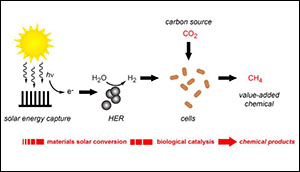Another Milestone in Hybrid Artificial Photosynthesis
6. 1. 2016 | Berkeley Lab | newscenter.lbl.gov
A team of researchers at the U.S. Department of Energy (DOE)’s Lawrence Berkeley National Laboratory (Berkeley Lab) developing a bioinorganic hybrid approach to artificial photosynthesis have achieved another milestone.
Having generated quite a buzz with their hybrid system of semiconducting nanowires and bacteria that used electrons to synthesize carbon dioxide into acetate, the team has now developed a hybrid system that produces renewable molecular hydrogen and uses it to synthesize carbon dioxide into methane, the primary constituent of natural gas.

Photosynthesis is the process by which nature harvests the energy in sunlight and uses it to synthesize carbohydrates from carbon dioxide and water. Carbohyrates are biomolecules that store the chemical energy used by living cells. In the original hybrid artificial photosynthesis system developed by the Berkeley Lab team, an array of silicon and titanium oxide nanowires collected solar energy and delivered electrons to microbes which used them to reduce carbon dioxide into a variety of value-added chemical products. In the new system, solar energy is used to split the water molecule into molecular oxygen and hydrogen. The hydrogen is then transported to microbes that use it to reduce carbon dioxide into one specific chemical product, methane.
Read more at Berkeley Lab
Image Credit: Berkeley Lab
-jk-




